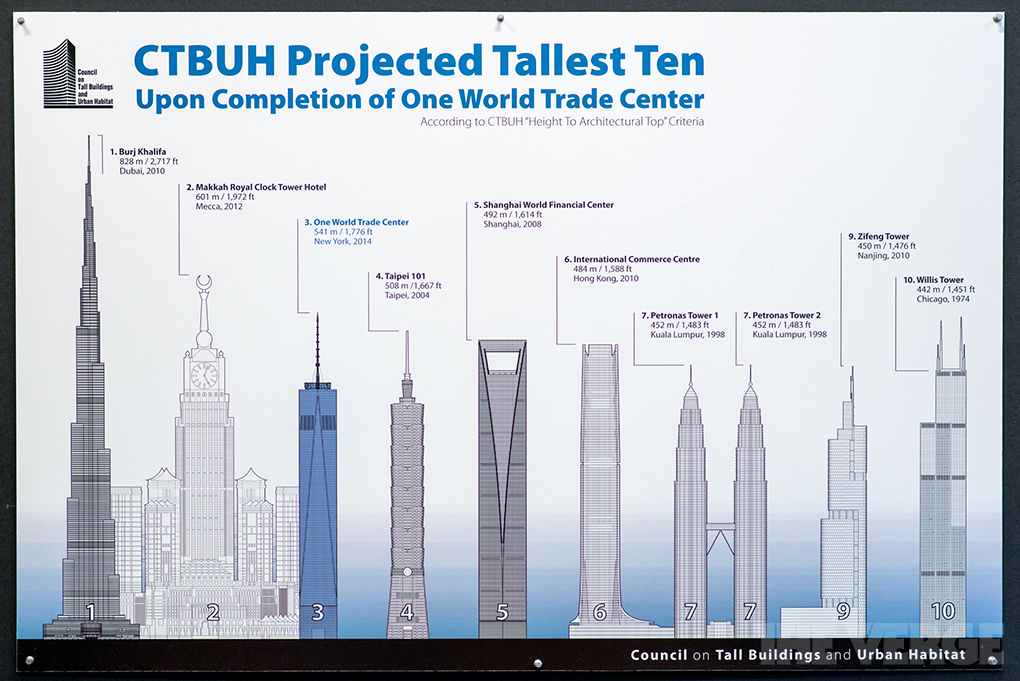[vc_row][vc_column][vc_column_text]
One World Trade Center Just Might Be!
By Dante D’Orazio on Email @dantedorazio
One World Trade CenterOne World Trade Center has been crowned the tallest building in the Americas, standing at a symbolic (and now official) 1,776 feet. The Council on Tall Buildings and Urban Habitat, an international body that determines the heights of skyscrapers, has ruled that the spire atop One World Trade is an architecturally significant feature of the building — not an antenna. Council chairman Timothy Johnson said that the spire was clearly “the end of the architectural expression of the building,” adding at a press conference today that “for us it was very clear that it was a spire and not an antenna.” Johnson is also a partner at NBBJ, a global architecture firm.
The decision makes the official height of the building 1,776 feet, not 1,368 feet, which is the height of the building’s roof. It also allows One World Trade to beat out Chicago’s Willis Tower as the tallest in the US. Willis Tower’s antenna does not count towards its official “architectural height.” Internationally, the Council is now projecting that One World Trade will be the third tallest building in the world upon completion, behind the 2,717-foot Burj Khalifa and the 1,972-foot Makkah Royal Clock Tower Hotel in Mecca.

One World Trade Center’s spire doesn’t include any radio or broadcast equipment — it only features decorative lighting — and that fact seems to have helped it win the Council’s favor. Johnson explained that “having been on the roof of the World Trade, this is essentially a small building up there,” referring to the spire. He added that a small lightning rod and a light above the spire that serves to warn airplanes do not count towards the height, and the 1,776-foot measurement does not include those minor functional pieces of equipment.
The 25-person Council, comprised of architects, engineers, contractors, academics, and suppliers, met on November 8th in Chicago to make a decision, and as it typically does, the council re-evaluated its criteria before making a ruling. The team concluded that the rules were valid, and then made the unanimous decision to rule that the spire was not an antenna. As for the actual measurement 1,776 feet, the Council relies on One World Trade’s architectural plans. This means that the team is “basically taking the word of the architects and engineers,” as Johnson explained, noting that the procedure is the same for all other skyscrapers.
There are three different height criteria used by the Council on Tall Buildings and Urban Habitat: “height to the architectural top,” “highest occupied floor,” and “height to tip.” The Willis Tower beats out One World Trade for the highest occupied floor, at 1,354 feet vs. 1,268 feet. Only the architectural height is used to determine the tallest buildings in the world, however, and it’s also the most controversial. This measurement officially includes spires, but not “antennae, signage, flag poles or other functional-technical equipment.”
“FOR US IT WAS VERY CLEAR THAT IT WAS A SPIRE AND NOT AN ANTENNA.”
Not only does One World Trade’s spire not include functional equipment, it also is perceived as a permanent fixture on the building. Antennas like that found on Willis Tower have been swapped out and removed in the past. Indeed, the Willis Tower — called the Sears Tower at the time — had its two antennas added in the early ’80s, close to ten years after the building’s completion. In 2000 one of the antennas was replaced with a taller antenna for improved reception. The spire on One World Trade, in contrast, is made of stainless steel and is integrated into the building’s design, according to the Council. Should it ever be replaced or repurposed as an antenna, the Council would revisit its decision, according to Johnson.
The decision was clearly fraught with political interest, and some may point to those forces as influencing the decision today. Johnson said in light of the pressure that “we were very happy that our conclusion was that we were able to ratify that that was the height of the building.”
[/vc_column_text][/vc_column][/vc_row][vc_row][vc_column width=”1/1″][vc_wp_posts show_date=”1″ title=”Denver Window Blog” number=”1″][/vc_column][/vc_row]
